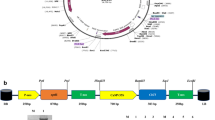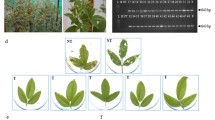Abstract
Chickpea is the world’s third most important pulse crop and India produces 75% of the world’s supply. Chickpea seeds are attacked byCallosobruchus maculatus andC. chinensis which cause extensive damage. The α-amylase inhibitor gene isolated fromPhaseolus vulgaris seeds was introduced into chickpea cultivar K850 throughAgrobacterium- mediated transformation. A total of 288 kanamycin resistant plants were regenerated. Only 0.3% of these were true transformants. Polymerase chain reaction (PCR) analysis and Southern hybridization confirmed the presence of 4.9 kb α-amylase inhibitor gene in the transformed plants. Western blot confirmed the presence of α-amylase inhibitor protein. The results of bioassay study revealed a significant reduction in the survival rate of bruchid weevilC. maculatus reared on transgenic chickpea seeds. All the transgenic plants exhibited a segregation ratio of 3:1.
Similar content being viewed by others
References
Boulter D 1993 Insect pest control by copying nature using genetically engineered crops;Phytochemistry 34 1453–1466
Dayal S, Lavanya M, Devi P and Sharma K K 2003 An efficient protocol for shoot regeneration and genetic transformation of pigeon pea [Cajanus cajan (L.) Millsp.] using leaf explants;Plant Cell Rep. 21 1072–1079
Ditta G, Stanfield S, Corbin D and Helinski D R 1980 Bruchid host range cloning system for gram-negative bacterium. Construction of gene bank ofRhizobium meliloti;Proc. Natl. Acad. Sci. USA 77 7347–7351
Geervani P and Umadevi T 1989 Effect of maturation of nutrient composition of selected vegetable legumes;J. Sci. FoodAgric. 46 243–248
Grant J E, Thomsons L M J, Joyce M D P, Dale T M and Cooper P A 2003 Influence ofAgrobacterium tumefaciens strain on the production of transgenic peas (Pisum sativum L.);Plant Cell Rep. 12 1207–1210
Ishimoto M and Chrispeels M J 1996 Protective mechanism of the Mexican bean weevil against high levels of α-amylase inhibitor in the common bean;Physiol. Plant. 111 393–401
Ishimoto M, Sato T, Chrispeels M J and Kitamura K 1996 Bruchid resistance of transgenic azuki bean expressing seeds α-amylase inhibitor of the common bean;Entmol. Exp Appl. 79 309–315
Jaiwal P K, Kumari R, Ignacimuthu S, Potrykus I and Sautter C 2001Agrobacterium tumefaciens-mediated genetic transformation of mungbean (Vigna radiata L. Wilczek) - a recalcitrant grain legume;Plant Sci. 161 239–247
Jefferson R A 1987 Assaying Chimeric genes in plants: theGus gene fusion system;Plant Mol. Biol. Rep. 5 387–405
Kar S, Basu D, Das S, Ramakrishnan N A, Mukherjee P, Nayak P, Sen S K 1997 Expression of cry 1A(c) gene ofBacillus thuringiensis in transgenic chickpea plants inhibits development of podborer (Heliothis armigera) larvae;Trans. Res. 6 177–185
Krishnamurthy K V, Suhasini K, Sagare A P, Meixner M, de Kathen A, Pickardt T, Schieder O and Kathen de A 2000Agrobacterium mediated transformation of chickpea (Cicer arietinum L.) embryo axes;Plant Cell Rep. 19 235–240
Morton R L, Schroeder H E, Bate K S, Chrispeels M J, Armstron G E and Higgins T J V 2000 Bean α-amylase inhibitor 1 in transgenic peas (Pisum sativum) provides complete protection from pea weevil (Bruchus pisorum) under field conditions;Proc. Natl. Acad. Sci. USA 97 3820–3825
Piergiovanni A R 1992 Effects of some experimental parameters on the activity of cowpea alpha amylase inhibitors;Lebens. Wiss. Technol. 25 321–324
Rogers S O and Bendich A J 1994 Extraction of total cellular DNA from plants, algae and fungi; inPlant molecular biology (eds) S B Gelvin and R A Schilperoort (The Netherlands: Kluwer) 2nd edition, D1, pp 1–8.
Ryan C A 1990 Protease inhibitors in plants. Genes for improving defense against insects and pathogens;Annu. Rev. Phytopathol. 28 25–45
Saini R, Jaiwal S and Jaiwal PK 2003 Stable genetic transformation ofVigna mungo L. Hepper viaAgrobacterium tumefaciens;Plant Cell Rep. 21 701–705
Sanyal I, Singh A K and Amala D V 2003Agrobacterium tumefaciens-mediated transformation of chickpea (Cicer arietinum L.) using mature embryonic axes and cotyledonary nodes;Indian J. Biotechnol. 2 524–532
Sarmah B K, Moore A, Tate W, Molvig L, Morton R L, Rees D P, Chiaiese P, Chrispeels M J, Tabe L M and Higgins T J V 2004 Transgenic chickpea seeds expressing high levels of a bean α-amylase inhibitor;Mol. Breed. 14 73–82.
Schroeder H E, Gollash S and Moore A 1995 Bean α-amylase inhibitor confers resistance to the pea weevil (Bruchus pisorum) in transgenic peas (Pisum sativum L.);Plant Physiol. 107 1233–1239
Shade R E, Schroeder R E, Poueyo J J, Tabe L M, Murdock L I, Higgins T J V and Chrispeels M J 1994 Transgenic pea seeds expressing the α-amylase inhibitor of the common bean are resistant to bruchid beetles;Bio/Technology 12 793–796
Singh K B, Malhotra R S, Halila H M, Knights E J and Verma M M 1994 Current status and future strategy in breeding chickpea for resistance to biotic and abiotic stresses;Euphytica 73 137–149
Soni G L, George M and Singh R 1982 Role of common Indian pulses as hypocholesterolemic agents;Indian J. Nutr. Diebet. 19 184–189
Tewari-Singh N, Sen J, Kiesecker H, Reddy V S, Jacobsen H J and Guha-Mukherjee S 2004 Use of herbicide or lysine plus threonine for non-antibiotic selection of transgenic chickpea;Plant Cell Rep. 22 576–583
Ussuf K K, Laxmi N H and Mita R 2001 Protease inhibitors: plant derived genes of insecticidal protein for developing insect resistant transgenic plants;Curr. Sci. 80 847–853
Author information
Authors and Affiliations
Corresponding author
Rights and permissions
About this article
Cite this article
Ignacimuthu, S., Prakash, S. Agrobacterium-mediated transformation of chickpea with α-amylase inhibitor gene for insect resistance. J. Biosci. 31, 339–345 (2006). https://doi.org/10.1007/BF02704106
Received:
Accepted:
Published:
Issue Date:
DOI: https://doi.org/10.1007/BF02704106




